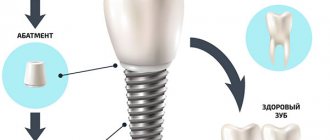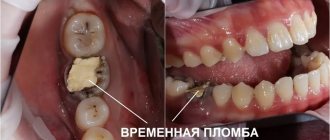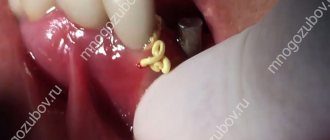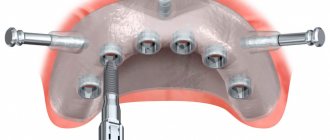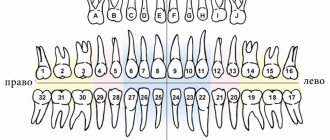- Indications
- Contraindications
- Methods
- Simple
- Complex
- Low-traumatic methods
- Broken tooth or root
- Orthodontic
- For inflammation
- Before implantation
- By tooth location
- Recommendations after removal
- Prices
- Doctors
- Reviews
Tooth extraction in dentistry occurs if therapeutic measures are ineffective. But it is worth remembering that the main task of all dentists is to preserve the tooth and removal is an extreme, forced measure.
Indications for removal
With the development of new technologies, equipment, and highly qualified doctors, there are fewer indications for tooth extraction. But still they exist and this:
- severe damage to the subgingival and coronal parts with the impossibility of saving it;
- tooth mobility grade 3-4 (with periodontitis);
- teeth with impaired patency of root canals (with periodontitis);
- enlarging cyst from 0.7 cm (could not be cured by other methods);
- incorrect placement of wisdom teeth (and others), which interferes, injures the mucous membrane, and causes discomfort;
- injured tooth (fracture, large chips);
- tumor of the jaw bones and tissues;
- difficult eruption;
- for orthodontic treatment (bite correction);
- for orthopedic treatment (installation of a prosthesis).
Dystopian tooth from 9,500 rub.
Simple from 3,500 rub.
Piezosurgery from 9,500 rub.
Complex from 9,500 rub.
Wisdom tooth removal from RUR 3,500
Tooth root removal from RUB 1,000.
How is a decayed tooth removed?
The process of tooth extraction is a simple dental operation. The difficulty increases when you need to remove the root of a tooth that is completely destroyed. Factors requiring the intervention of an experienced specialist:
- small size of the remaining crown;
- condition of surrounding tissues;
- the location of the remaining hard tooth tissues under the upper edge of the gums;
- defects of gums, roots.
Affects the complexity of the operation and whether the position of the upper or lower jaw belongs. In the upper jaw, the walls of the sockets are longer and thicker; accordingly, teeth are removed from them with great difficulty - a highly qualified dentist is required to perform the manipulation.
Wisdom teeth, from which only the root remains, are removed in the same way as ordinary molars, but in some patients, healing after such an intervention is very painful.
Examination and preparation
The procedure begins with a thorough examination and preparation of the patient. When you first visit the clinic, the doctor will take an x-ray and examine the oral cavity.
Doctor's tasks:
- determine the condition of the tooth, assess the extent of destruction;
- clarify the presence of allergies, contraindications, inflammation;
- choose a method of pain relief;
- draw up an operation plan;
- prepare tools.
The tools used to remove a rotten tooth root are a drill, forceps, and a set of elevators (photo).
A prerequisite is hygienic treatment of adjacent tissues. Extraction is possible only after removing stones and plaque from the molars, incisors or canines surrounding the surgical field. Immediately before extraction, the oral cavity is treated with a Chlorhexidine solution.
Anesthesia
There are cases when dentin is destroyed gradually, without inflammation, without the appearance of rot. In such situations, painless root removal is possible without the use of painkillers, however, anesthesia is more often necessary.
The choice of drug is carried out taking into account:
- age;
- allergic status;
- presence of somatic diseases;
- individual intolerance to drugs;
- presence of chronic diseases: epilepsy, diabetes;
- complexity of the upcoming operation.
The patient must notify the dentist about any deviations before the procedure begins. In most cases, the tooth root is removed under local anesthesia - one or two injections for incisors, 2 to 4 injections into the gums for molars. But if two teeth are destroyed, or the jaw is to be opened, the patient receives general anesthesia - he will sleep until the doctor finishes pulling out the tooth.
Features of pain relief for a tooth with a rotten root
An anesthetic injection is given at the site of the projection of the tooth roots. But if the medicine is injected into the rotten area, it may not work and the person will be hurt during the extraction process.
Treatment of patients with rotten roots is carried out in two stages. On the first visit, the dentist numbs the gum, prepares it and cleans it of pus. During the second visit, anesthesia is repeated, and the doctor removes the root that has rotted inside the gum.
Removal
The doctor decides how to remove a tooth if only the root remains. Usually they start with the use of forceps. Even if the destroyed roots remain under the gum, the holes do not completely heal - the dentist can carefully pick up the remnants of hard tissue and easily pull them out.
If the tooth has crumbled to the very base, it is pulled out with an elevator. Having inserted the instrument between the gum and dentin, the doctor presses on the handle and makes rotational movements of small amplitude. As a result, the periodontal fibers shift and the root is squeezed out of the socket.
A drill is used when it is necessary to crush the hard tissues of a molar before removal. With proper anesthesia, this procedure is painless; discomfort is possible only when the gums are already healing.
Relieving inflammation
When removing a rotten root, an inflammatory process is often detected. To ensure that the wound heals safely and does not fester, it is customary to treat it with an antiseptic. But one treatment will not provide adequate prevention, so an anti-inflammatory drug is placed in a fresh hole. With it, the hole will heal faster, and the patient will have less chance of developing alveolitis.
Stitching
To extract the root system, the doctor separates and lifts flaps of soft tissue; they can only be attached back by suturing. It is customary to tighten the edges of the holes with threads during double or triple removal, when a significant part of the gum has been subjected to preparation. This is done so that the affected area heals faster and does not cause discomfort to the patient.
Methods and types of removal
Tooth extraction in dentistry is divided into simple (using forceps), surgical (with excision of tissue and/or tooth), and recently another type has been added - atraumatic (using modern technologies).
Types of removal:
- complete
removal of the tooth along with the root; - resection
- removal of the top of the root. Usually in the presence of granulomas or cysts; - hemisection
- one root is removed, leaving the crown and other roots.
Contraindications
Before removing a tooth from above, the doctor conducts a diagnosis, identifying the presence of contraindications in the patient. If a person has acute infectious inflammation, the acute phase of mental illness, diabetes mellitus, systemic diseases of the heart muscle or poor blood clotting, extraction is not performed. It is not indicated in the first and last months of pregnancy, when women begin their periods. If contraindications are identified, the surgeon postpones the operation to a more favorable moment.
Easy removal
A simple extraction method is performed if the crown is well preserved and there are no complications. The doctor uses forceps consisting of handles, cheeks and a lock, sometimes an elevator when the root is deep in the alveolar socket.
The method is simple and less traumatic. It can be planned - for subsequent prosthetics, tooth trauma, its looseness, for braces. It can be an emergency - the cause is caries, pulpitis, infection of tissue at the root and a condition that can be harmful to health. Extraction is carried out urgently.
Simple removal steps:
- Local anesthesia in a selected dosage
- Removing the gums and applying forceps
- Loosening. The upper incisors are rotated with rotational movements, they have a cone-shaped root, while the lower ones have a more complex root structure - they are rocked
- Extraction from the alveolar socket
The front teeth are painlessly removed and the procedure takes up to 30 minutes.
, recovery is fast.
Sometimes people wonder how many teeth can be pulled out during a visit. Usually one or two teeth are extracted in one visit. Removal of three teeth at once most often refers to children's milk teeth.
Alternatives
An alternative method for restoring sixes is a bridge prosthesis. This is a structure consisting of crowns tightly connected to each other. To restore one tooth, the bridge consists of 3 crowns. The two outer ones are fixed on the teeth on both sides of the defect. The supporting teeth are ground down to form the internal cavity of the outer crowns of the prosthesis. The middle crown is hinged and imitates the lost six.
This option is cheaper than implantation, but has disadvantages - grinding the enamel of living teeth leads to a reduction in their service life. Another important point is that the bone under the hinged crown does not receive stress during chewing, so bone tissue atrophy is inevitable.
Difficult removal
The use of special tools and clear actions of the doctor are necessary if the task is complex tooth extraction without pain. The method is used when:
- the presence of several roots, the root canals are curved and touch neighboring elements;
- atypical position of the tooth, not in a row, horizontal position, under the gum or recessed into the jawbone;
- severe destruction, during manipulation the tooth may simply crumble;
- the presence of enlarging cysts, granulomas;
- the root has fused with the bone tissue.
Doctors also use surgical removal of a permanent tooth in cases where it is difficult to reach. Often these are problematic figure eights at the bottom and surgery is performed to remove a tooth in the lower jaw.
Removal steps using the complex method:
- Anesthesia. Stronger, because the operation takes longer.
- An incision in the gum with a scalpel.
- Sawing out a piece of bone or sawing a tooth into pieces.
- Extraction from the hole.
- Stitching. These can be self-absorbing or non-absorbing, at the discretion of the surgeon.
The process of removing a molar tooth using a complex surgical method can take from half an hour to two hours.
.
Is it possible to remove it at home?
Removing a tooth on your own is dangerous; at home, it is difficult to ensure sterility, numb the gums, ensure that the root is completely pulled out, and prevent blood loss and other complications. You can remove only a very loose tooth yourself without risk to your health.
Typically, children's loose baby teeth are removed at home. It is important to remove food debris and thoroughly disinfect the oral cavity. You need to tightly grasp the tooth with your fingers wrapped in sterile gauze, loosen it well and only then pull it. If after the second attempt you are unable to pull out the tooth, entrust this difficult manipulation to an experienced dentist without risking your health.
If the tooth comes out of the socket easily, you need to press the gauze swab firmly onto the wound to stop the bleeding and hold it for 30-40 minutes. You should refrain from eating for two hours.
If any unpleasant discomfort occurs, it is advisable to consult a dentist as soon as possible to prevent complications from developing.
Finally, I would like to remind you: simple preventive measures will allow you to keep your smile snow-white and your teeth healthy and strong for many years.
Low-traumatic removal methods
Science is developing rapidly, everything is being done to make a person’s life comfortable, including new atraumatic methods of tooth extraction. Less time is spent on the procedure, forceps are not used, and the result is a complex tooth extraction without pain
.
These are ultrasound, laser removal techniques, and piezosurgery. For example, ultrasound
acts on hard tissues, does not injure the gums, blood vessels and capillaries, and does not affect nerves. The device carefully and accurately separates the gum from the tooth, while at the same time, a physiological solution is supplied during the process to speed up the healing of the hole.
The ultrasound method is often used in dental clinics to extract wisdom teeth in the lower jaw. Its location and roots usually require not a simple tooth extraction by a doctor, but a surgically complex one.
The advantages of such methods:
- painlessness;
- reducing the risk of infection;
- less blood;
- preservation of gum relief.
The downside is the high cost of tooth extraction both in Moscow and in the regions. But when it comes to the health of yourself and your loved ones, the price of tooth extraction in a clinic is not the most important factor.
Let's look at the extraction features of some cases.
Removal of broken tooth and root
A broken tooth with a chip, crack, or severely damaged tooth with a damaged root must be removed.
After the anesthesia begins to take effect, the doctor, using forceps, moves the gum back and pries out the remains of the root. Then he removes it from the hole. Sometimes an elevator is required to loosen the remains of the tooth and break the bonds holding it in the bone.
If root fragments are detected visually or on x-ray, a surgical procedure is required. An incision is made in the soft tissues of the gum until the root is exposed, and the dental surgeon completely removes the fragments.
If a wisdom tooth is broken in a difficult situation, after cutting the gum, part of the bone is sawed out, and the root and fragments are removed. Stitches are applied. The operation to remove a tooth on the lower jaw is more difficult
due to the bone structure and roots underneath.
Is it worth getting an implant?
The absence of the sixth tooth threatens:
- displacement of neighboring units;
- advancement of antagonists on the opposite jaw.
Neighboring and antagonist teeth will slowly shift, which threatens to expose the roots, the appearance of wedge-shaped defects at the gum itself, exposure of the neck, which is sensitive to changes in temperature of water and food, and pain. In addition, there will be a change in the bite, since the teeth will be out of place. Therefore, it is necessary to place an implant to maintain healthy teeth and correct bite.
Orthodontic removal
Removal for orthodontic reasons is associated with further work to change the malocclusion and install crowns. To do this, sometimes you have to remove healthy elements.
If there is not enough space for the teeth, they grow incorrectly, the doctor may decide to remove several teeth at once. More often these are the fourth or fifth teeth. Extraction of the sixth tooth is done extremely rarely; in this case, the “fulcrum” is lost, which can affect the effectiveness of the entire treatment. Without these two teeth, there will be a space that will allow the crookedness to be corrected.
Elements are removed in case of malocclusion, when the lower jaw protrudes above the upper jaw or vice versa. Also with asymmetry of the dentition.
Molar tooth extraction in children
A child’s molar can be either a baby tooth or a permanent tooth; depending on this, treatment tactics are differentiated. If the permanent one has already begun to grow, and the milk tooth has not yet fallen out, but is already wobbly, the pediatric dentist will definitely advise removing the milk tooth that is interfering with normal eruption. If a baby’s permanent molar tooth hurts, the doctor will give preference to conservative treatment in order to preserve the integrity of the dentition.
Premature extraction of baby teeth is undesirable; it negatively affects the formation of the bite.
Clear indications for extraction in children are:
- the presence of a granuloma or dental root cyst.
- inflammation of the tooth root, mandibular nerve.
- complete destruction of the crown.
Features of tooth extraction with a cyst, flux, inflammation
If a cyst is discovered on a tooth, which could not be cured therapeutically or is already in an advanced state, a radical solution remains. Extraction.
Cyst
- a benign neoplasm, is a vesicle with liquid or pus. The infectious disease affects the jaw bone tissue and/or the root of a tooth inflamed by bacteria.
Dentists try to preserve the tooth, not remove the damaged one completely, and use the following methods:
- cystotomy
(removal of the anterior membrane of the cyst, leaving the other membranes); - hemisection
(removal of the root with the cyst); - cystectomy
(removal of all membranes containing the cyst: soft and hard).
Tooth extraction during flux occurs with a stronger anesthetic according to the following scenario: the periosteum is incised, the pus is cleaned out, damaged tissue and the “bad” tooth are removed in whole or in parts, and drainage is installed.
Indications and contraindications
Indications for removal are:
- tooth root fractures;
- severe destruction;
- chronic form of periodontitis;
- atypical structure, inclusion or dystonia, leading to pathologies (difficulty opening the mouth, diction disorders, etc.);
- advanced caries;
- strong mobility;
- crowded teeth;
- neoplasm on soft tissues near the root, large cysts.
Contraindications:
- canine removal (treatment recommended);
- pregnancy;
- mental disorders;
- traumatic brain injuries;
- epileptic seizures;
- diabetes;
- diseases of the nervous and respiratory systems.
Before removal, the doctor conducts a thorough examination, determines whether the tooth can be saved and what measures need to be taken to achieve this. In most cases, doctors prefer treatment, as this allows the functionality of the row and aesthetics to be preserved.
Features of tooth extraction before implantation
If a dental implant is to be placed in the future, after extraction, which is therefore made as atraumatic as possible, bone material and a membrane are placed on the hole and sutured. After restoration, the site will be perfect for an implant; no bone grafting will be required. There is a technology for installing an implant immediately after tooth extraction - immediate implantation. Everything is discussed with the implantologist in advance.
Do not remove teeth in advance; first you need to make an appointment with a specialist and get a consultation and an action plan. Or you can incur the additional cost of bone grafting yourself before implantation. And installation of implants definitely cannot be done inexpensively.
Features of implantation of the 6th lower tooth
The six of the lower jaw bears more loads during chewing than the upper jaw. Therefore, implants are selected taking this fact into account - wide and of sufficient length. The nuances of implantation from below:
- easier to carry out than on the top;
- implants take root faster - in 2-4 months, since the jawbone is denser and anatomically higher;
- but there is a risk of damage to the trigeminal nerve if the protocol is not followed, which is complicated by numbness of the chin and lips.
If the bone is small in height, then a preliminary operation is performed to increase it. The gum is peeled off, bone material is added, and a resorbable membrane is applied to secure it. Recovery takes up to six months.
Without preliminary bone grafting, surgery is possible if the atrophy is moderate. In this case, our Center uses bone growth stimulants. They are fixed to the neck of the artificial root during its installation and trigger the processes of bone tissue regeneration. In this case, implant healing and bone tissue growth occur simultaneously.
Upper - lower, anterior or chewing - difference in removal
Anatomically, the jaws have a different structure. They carry different loads. This also applies to teeth. Removal from above is much easier due to the porous structure of the bone tissue and the semi-elliptical arrangement of the row of teeth.
The front teeth, canines and incisors are inclined outward and have one root, while the chewing teeth are multi-rooted. Simple removal of the upper tooth occurs by applying forceps and shaking (rotation, rotation). Premolars: the fourth tooth has two or three roots, the fifth has one and uses S-shaped forceps. Molars, sixth, seventh chewing teeth are removed with the same forceps as the fifth premolar, but with a spike on one cheek. The roots diverge to the sides complicate the extraction process. In some cases, the tooth has to be removed in parts, after cutting it with a tool. Impacted teeth require cutting of soft tissues, working with a drill, putting medicine into the hole after removing the element, and suturing.
Removal of lower teeth has a number of features. The lower incisors are weak and can be removed easily and painlessly using forceps curved at 90° with narrow cheeks. Premolars (fifth and sixth) are removed using lower molar forceps. The sixth and seventh teeth on the lower jaw are the most complex - they are powerful and large. For them, forceps with wide triangular cheeks and spikes are used. The bone tissue in the lower jaw is denser, the teeth sit more firmly and have more branched roots.
How do dental surgeons remove wisdom teeth?
Typically, removing an upper wisdom tooth is easier than removing a lower wisdom tooth. This is due to the fact that the bone tissue of the upper jaw is softer and more porous, and therefore it is much more difficult to break off one of the roots (when removing a tooth from the socket). However, on the other hand, if the doctor does break off the top of one of the roots, then removing it from the upper jaw will be much more difficult. The latter is due both to the lack of good visual access and to the fact that working with thin elevators necessary to extract the root apex from the socket is much more dangerous in soft bone.
The bone tissue of the lower jaw is much denser, and lower wisdom teeth almost always have massive and/or often curved roots. Therefore, the roots of the lower wisdom teeth generally break off more often than the upper ones. But the doctor always has the opportunity to reduce the risk of such an outcome by taking an x-ray that will show us the shape and position of the roots in the jaw. If there is a risk of breaking off the root during tooth extraction, a good doctor will first saw it into pieces, after which he will separately remove the roots and parts of the crown. All this usually takes less than 15 minutes, but you come to understand this with experience.
But most often you can find a different picture, when the doctor uses all his might to loosen the tooth with forceps or tries to dislocate the tooth from the socket with an elevator, but one of the roots suddenly breaks off. Then the doctor begins to either pick at the wound for a long time with a thin elevator, or drill out the bone tissue (to get to the broken off tip of the root). In both cases, very significant trauma is caused to the jaw, which will lead to severe pain and inflammation of the wound in the postoperative period. Therefore, experience and understanding of the extraction strategy play a big role, and sometimes even a very complex tooth, on which one doctor can spend a whole hour, another may need only 5-10 minutes.
Simple and complex wisdom tooth removal –
Thus, removing the eighth tooth can be either simple or complex. In some cases, we can assume in advance that there will be a difficult removal. Here are a few options at a glance: 1) we need to remove a tooth that has not yet erupted above the mucous membrane, 2) on the x-ray we see curved roots, 3) the tooth has a strong slope towards the 7th tooth, resting against it with the crown in the cervical area, 4) the tooth has a horizontal position in the jaw, 5) the crown of the tooth is almost completely destroyed and there is no way to “catch” on it with instruments.
Variants of the position of the wisdom tooth in the jaw -
With similar options for the position of the wisdom tooth (as in the radiographs above), we plan a complex extraction in advance. But even removing such teeth with the right strategy may not be too difficult, taking only 15-20 minutes. Below we will describe in detail how simple wisdom tooth removal is carried out, and also show one of the options for complex removal.
Recommendations after removal
In order for rehabilitation to go smoothly and quickly, the following rules must be followed:
- do not eat or drink for 2-3 hours;
- exclude hot food and drinks for a week;
- avoid hard foods;
- refrain from brushing your teeth on the first day, then use a brush with soft bristles;
- postpone active physical activities.
The healing process usually lasts about a week
. The doctor may prescribe antibiotics, anti-inflammatory drugs, rinses (baths) with antiseptics.
Complications can occur after any operation:
- bleeding of the socket;
- not the entire tooth was removed;
- alveolitis (inflammation and suppuration of the walls of the socket);
- loss of sensitivity of the tongue and lips (paresthesia).
If you neglect the symptoms and do not start treatment on time, everything can go into an unfavorable stage: osteomyelitis of the jaw, abscess, phlegmon. Carry out tooth extraction in a dental clinic that you can trust, with a license and recommendations, regardless of whether it is a paid tooth extraction or under a compulsory medical insurance policy.
Article Expert
Voznyuk Vladimir Aleksandrovich Implant surgeon, doctor of the highest category
Work experience: more than 35 years
Advantages of contacting ROOTT
Tooth extraction is a serious surgical procedure; we advise you to entrust this to the professional doctors of the ROOTT clinic.
An anamnesis will be collected: complaints, an x-ray to specify the topography of the element, root system, and degree of damage. The type of anesthesia is specified, whether there are any allergic reactions, what medications are taken (may affect blood clotting). At the appointed time, you will need to try to relax (we understand, this is difficult, but necessary), we will then act.
Vast experience, qualified doctors, innovative equipment, sterile rooms, instruments. Modern pain management and constant monitoring both during and after surgery guarantee a favorable outcome of the operation.
Our dentists always take an individual approach to each patient and their problem; removal occurs as gently and quickly as possible. Afterwards they will give recommendations or select treatment for speedy rehabilitation.
Prices
Free online consultation with a dentist
| Service | Price |
| Tooth root removal | from 1,000 rub. |
| Removal of a tooth with a high degree of mobility (for periodontal disease) | from 1,000 rub. |
| Simple tooth extraction | from 3,500 rub. |
| Removal of an impacted/dystopic tooth | from 9,500 rub. |
Consultation and diagnostics are free!
All prices Promotions
Sign up for a consultation
three ROOTT specialists + diagnostics as a gift
Guarantees
In our Center, implants are installed with a lifetime warranty from the manufacturer - Nobel Biocare. We provide guarantees:
- lifetime for the installation of implants;
- 1 year for crowns.
The warranty program includes a complex for the implant, surgery, bone reconstruction and prosthetics.
The guarantee is valid provided that the patient follows the doctor’s recommendations, care rules and regularly visits the dentist.



